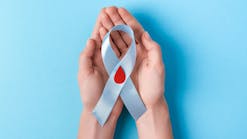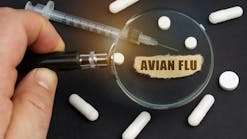Troy Taylor
This month, MLO is pleased to introduce to its
International Corner Betsy Hanna, vice president of EMEA (Europe, Middle
East, Africa), and Troy Taylor, vice president, Worldwide Customer
Technical Service, both headquartered at Ortho Clinical Diagnostics, in
Raritan, NJ. Ms. Hanna and Mr. Taylor answer several questions about the
company's global activities.
MLO: While many organizations embrace the concept
of “global” as a relatively new way of doing business, it appears that
Ortho Clinical Diagnostics (OCD) perhaps added more “global” flair to
its operations as it announced the launch of its Remote Monitoring
Center in Strasbourg, serving 18 countries. Obviously, OCD's European
Support Center (ESC) was operating for some 20 years in Strasbourg
before this important launch. Is the RMC the only “arm” of the
organization that moved from America to Europe, with plans to move to
the Asia-Pacific region, and other venues overseas?
Taylor: Our business has always been global in
nature. The technical support operation evolved from a loose collection
of regional functions into a tight-knit global operation, so now we use
state-of-the-art technology with common systems, processes, and
standards to connect systems that enhance the experience of our
customers around the world. One example of this is the global Remote
Monitoring Center, which is a network of high-tech centers in the United
States (Rochester, NY) and Europe (Strasbourg, France), that provides
24/7 proactive monitoring of the worldwide installed base of
instruments. Additionally, we have also maintained ongoing operations in
our state-of-the-art manufacturing facility in Wales, which in 2009
moved into a new location in Pencoed.
MLO: Was the Strasbourg Remote Monitoring Center
launch the initiation of the concept of “360^0 support” for customers
around the world? Or was this an addition to other operations that were
already functioning in France and other countries?
Taylor: The Remote Monitoring Center is the
newest investment we have made, in addition to the Call Center and Field
Engineering service that Ortho Clinical Diagnostics deploys as standard
resources to perform service work for customers. We believe in the value
of getting services completed in the quickest possible way, so we are
investing in the technology as a means of enhancing our value to our
customers' operations.
MLO: How does OCD impact all things “clinical
laboratory,” aside from this new Remote Monitoring Center?
Hanna: We are committed to providing customers
with products, services, and process solutions to make labs more
efficient in delivering the quality test results that doctors and
patients need. For instance, we have released 120 assays available on
the VITROS 5600 Integrated and the VITROS 3600 Immunodiagnostic Systems.
The VITROS assay menu covers 90% of the top 100 assays and 99% of
laboratory test volume, with numerous other assays in development.
MLO: So far, what feedback are you receiving from
customers in terms of the performance of the new center in Strasbourg
and how the service impacts the day-to-day operations of their clinical
labs?
Taylor: The feedback has been overwhelming
positive, not only in terms of what we have achieved, but the
possibilities that customers had not previously imagined. As a recent
example, an alert from a VITROS Instrument in Europe showed a system
operating at a higher temperature than normal. By comparing temperature
readings inside and outside the instrument, our remote technical support
staff concluded that blocked ventilation may be the culprit. A call to
the laboratory revealed that the instrument was pushed too close to the
wall, and the problem was quickly solved by having the laboratory
technician move it farther away. This quick analysis and resolution not
only minimized potential downtime, but saved the customer potential
field-service costs.
MLO: If OCD operates in developing countries, are
there perhaps one or two products used more frequently than those used
in Europe or in America?
Hanna: Our clinical lab business growth has been
very high in Mexico, Brazil, and India. Furthermore, products used in
developing countries tend to be the smaller, simpler instruments like
our DT60 desktop instrument, VITROS 350, and ECiQ. An added benefit of
VITROS chemistry technology is the MicroSlide — an entire integrated
test environment on a thin piece of film. Layered dry-slide technology
enables separate reaction domains, so each step can be optimized to
provide excellent precision and accuracy. This technology provides
high-quality results in diverse patient settings, reduces costs, and
offers convenience, especially for smaller labs that may not have access
to water or drains. Through investments in high-impact medical tests, as
well as other services and process solutions, we aim to enable
diagnostics to take on an even more important role in predicting disease
and reducing the burden of chronic illnesses.
MLO: Does OCD recognize any unmet needs or
demands for totally different types of products in different countries
(e.g., more HIV/AIDS tests are used perhaps in African countries than in
European countries)?
Hanna: As we continue to invest to develop our
assay portfolio, we assess unmet needs in all parts of the world. Our
portfolio under development today includes specialized
infectious-disease tests for some developing countries, as well as other
tests that are specific to a particular market or geography. We are
dedicated to investing significant resources to continuously improve our
products and develop solutions to address unmet medical needs. We offer
a complete infectious-disease testing menu in the U.S., including
Anti-HIV 1+2 and rubella, in addition to a comprehensive menu of routine
assays that can be run on a single platform. Recently, we received U.S.
FDA approval of the VITROS Anti-HIV 1+2 Assay for use on the VITROS 5600
Integrated and VITROS 3600 Immunodiagnostic Systems. This is the first
diagnostic assay approved for an integrated system in the United States,
allowing laboratories to run HIV and other routine tests on a single,
consolidated testing platform.
MLO: Taken together, what areas of opportunity or
focus are of the most critical importance to OCD?
Hanna: As a provider of high-quality, in vitro
diagnostic products, we are focused on developing tools to help give
patients a better quality of life at every point of care. Serving the
transfusion medicine community, Ortho Clinical Diagnostics is the
leading provider of donor screening and blood grouping and typing
products. For example, we recently launched the FETALSCREEN II Fetal
Maternal Hemorrhage Screening Test (in the U.S.), which aids in the
detection, prevention and management of Hemolytic Disease of the
Newborn, or HDN, a serious autoimmune disease caused by incompatibility
between the mother's and baby's blood.
MLO: In what ways does OCD provide additional
support for medical laboratories in those countries where its products
are used?
Taylor: The 24-hour Remote Monitoring Center is
designed to predict certain problems before they interrupt a
laboratory's ability to deliver high quality test results to doctors and
patients. With this service, technical support specialists and engineers
monitor performance, diagnose issues remotely, and when required,
schedule service at the customer's convenience, allowing laboratories to
optimize instrument uptime. Additionally, our ValuMetrix Consulting
Service helps clinical labs maximize their effectiveness through
benchmarking, optimization processes and healthcare consulting services
to achieve operational improvements, including increased capacity,
elimination of waste and improved quality. Using a systematic approach
to quality and operational process improvement, ValuMetrix services
helps laboratories address several challenges including skilled labor
shortages, budget reductions and increasing test volumes.
MLO: Does OCD use different marketing techniques
for each region or for each country when it begins to distribute its
products?
Hanna: While our marketing strategy and messages
are the same around the world, we believe it is important to tailor our
approach for delivering these messages in each market. Some recent
examples include our use of mobile marketing units (e.g., demonstration
trucks) in the U.S. and Japan where we take our new products to the
customers' site. In Europe, we bring customers and potential customers
together in our manufacturing facility for a different type of
demonstration there.
MLO: What challenges did/does the organization
face in developing its global business?
Hanna: Like many other global organizations, we
are faced with the challenge of balancing local requirements and special
needs with the broader, global “average” needs of customers. Another
important area is that of regulatory requirements — the needs and
requirements around the world are changing and it is becoming
increasingly challenging to keep a broad portfolio in compliance with
all of the global requirements. The same rings true when launching new
products.
MLO: We find it interesting that more than half
of the service department employees at the Remote Monitoring Center
Strasbourg facility are fluent in more than three languages — which are
the top five languages spoken among these 150 employees?
Taylor: One of the many benefits of the Remote
Monitoring Center Strasbourg facility is that it allows customers to
connect with technical support specialists in eight languages — English,
French, German, Spanish, Italian, Portuguese, Dutch, and Polish. The top
five languages spoken are English, French, Italian, Spanish, and German.
MLO: Of all the details that one must confront in
mastering global outreach, what are the “Top 3” suggestions you would
give a newly minted OCD employee who was pursuing the global arm of the
business — and would multiple language fluency be among those?
Hanna: 1) Be passionate about the IVD industry,
and possess knowledge of the global diagnostic and clinical laboratory
landscape. 2) Be fluent in at least one foreign language, including
fluency in up three native languages of neighboring countries (e.g., an
employee pursuing an opportunity in Spain may also want to become fluent
in French and Portuguese). 3) Get out into the marketplace — wherever
you are in the world. See our customers face-to-face and bring that
perspective back to the company.
MLO: Another aspect of OCD's “360^0” support is
the ValuMetrix Consulting Service, which helps clinical laboratories
maximize their effectiveness through a variety of processes, such as
benchmarking, increased capacity, and elimination of waste. Can you
explain how modern clinical laboratories would benefit from making
similar operational improvements?
Hanna: Using this model, clinical labs can
maximize their effectiveness, refine internal processes, and ensure they
are taking positive steps toward continuing to deliver quality results
physicians and patients need. By working from the “inside-out,” we
mastered the principles of LEAN manufacturing internally by focusing on
their supply chain, inventory, purchasing and the manufacturing floor.
By investing in employees and existing assets, we are able to increase
efficiency and productivity to provide customers with standardized,
high-quality instruments faster.
seem challenging at first, it is important to appreciate that these
processes yield significant benefits for not only lab managers and
employees,
but also the facility and its patients.
MLO: What are some of the common obstacles you
foresee labs facing if they were to implement similar changes?
Hanna: As with any operational change, lab
managers and employees will need to become accustomed to new processes.
Nonetheless, implementing these kinds of changes has been proven to show
improvements in quality, lower costs and increase turnaround times, all
through the elimination of waste. For example, an analysis of recent
projects showed that labs were able to cut annual labor costs by as much
as $950,000. They were also able to implement quality initiatives to
reduce rework and save more than $270,000 each year, as well as reduce
turnaround time by 54%.
MLO: Are there any reasons why a lab would be
hesitant to do so?
Hanna: Yes, because most operational improvement
initiatives require change. While implementing new and different
procedures may seem challenging at first, it is important to appreciate
that these processes yield significant benefits for not only lab
managers and employees, but also the facility and its patients.
MLO: Based on your experience, what type of
feedback is most common among lab employees when faced to make these
changes?
Hanna: There are many factors to take into
consideration. Generally, in the beginning we may encounter some
resistance from employees. However, when working closely with our
ValuMetrix Services Consulting group and laboratory leadership,
employees feel a sense of accomplishment as they successfully learn to
work more efficiently and effectively while embarking on their LEAN
journey. Lasting success comes to those organizations that increase
their success rate with change, shorten their change cycle time,
encourage innovation, and actively create change.





